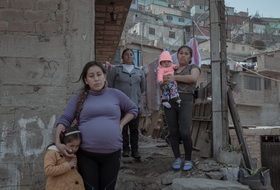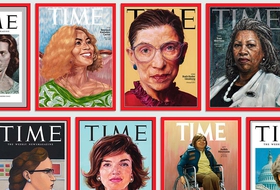
One in three women have suffered physical or sexual violence. With contributions from Europe, Africa, Asia and Latin America, we look at how this shadow pandemic affects every corner of the world.
Isis, borne of a leadership split within Al Qaeda, envisions the role of women differently from the historic organisation of Islamic militancy. According to Al Qaeda, women must be passive and submissive. For Isis, they must be subordinated, but they are also called to participate actively in the construction and maintenance of the Islamic Caliphate.
Isis, borne of a leadership split within Al Qaeda, envisions the role of women differently from the historic organisation of Islamic militancy. According to Al Qaeda, women must be passive and submissive. For Isis, they must be subordinated, but they are also called to participate actively in the construction and maintenance of the Islamic Caliphate.
Amongst the women of Isis there are also fighters, who are given responsibilities on a par with those of their male counterparts. Furthermore, two brigades, al-Khansaa e Umm al-Rayan, are composed exclusively of female members. They act as police bodies, monitoring women in their observance of the Islamic State’s laws and searching “women” suspected of being men who disguise themselves by wearing traditional female clothing: the niqab, a veil which covers the face.
The female presence in the ranks of the Islamic State has a domino effect. Through personal contacts and social media, women in Isis’s territory are directly involved in worldwide recruitment activities. It is estimated that 550 western women have already joined, ninety of whom tell of their life in Iraq and Syria through blogs and Twitter. A recent case was that of three British teenagers who were seen in Turkey on the 17th of February. It it thought that, from there, they entered Syria to take part in Isis’s jihad, or holy struggle.
France is amongst the western countries from which women recruits are joining the Islamic State. This is demonstrated by the following video, which was filmed in secret by a woman in Raqqa, Syria.
https://www.youtube.com/watch?v=1TkuAIKoI28
Women are considered essential pillars in the realisation of the social vision of the Islamic State, which is based on salafi Islam. Paradoxically, it is precisely this puritanical reading of the Qur’an that prescribes women a servile role. Salafi doctrine is expressed in Isis’s manifesto, which states that women have to leave their homes as little as possible, girls can be married from the age of nine and are to be educated only until they’re fifteen.
Women in Isis’s territory are forced to wear the niqab at all times, and the veil must be double-layered in order to cover their eyes. They must be dressed in black, in a long tunic called abaya and with gloves, according to testimonies collected by the Guardian. They aren’t allowed to leave their homes without a male escort, called mahram. If the religious police, hisbah, discovers any violations of these codes, the mahram is fined or whipped: punishments which are liable to aggravate women’s positions in the domestic context.
As well as restricting women’s liberties, Isis is conducting a veritable campaign of abuses against them. As has emerged from a recent gathering of Iraqi and Syrian feminists which took place in Istanbul, Isis uses rape as a weapon of war. This way, it subjugates its victims, weakening them psychologically and isolating them from their families because of the stigma attached to raped women.
There are also cases of forced marriages and women who are kidnapped and sold as slaves, amongst which are young girls of the yazidi ethno-religious minority, according to Human Rights Watch. Some women are forced into “jihad marriages”, becoming sexual objects for Isis fighters, says Yanar Mohammed, President of the Organisation of Women’s Freedom in Iraq.
From exploited women, to those whose liberties are crushed, to those who join the Islamic State, there are many points of contact between Isis and women. It is in the treatment of the female gender that the complexity and contradictions of the Islamic State in Iraq and Syria emerge.
Siamo anche su WhatsApp. Segui il canale ufficiale LifeGate per restare aggiornata, aggiornato sulle ultime notizie e sulle nostre attività.
![]()
Quest'opera è distribuita con Licenza Creative Commons Attribuzione - Non commerciale - Non opere derivate 4.0 Internazionale.
One in three women have suffered physical or sexual violence. With contributions from Europe, Africa, Asia and Latin America, we look at how this shadow pandemic affects every corner of the world.
The Istanbul Convention against gender-based and domestic violence marks its tenth anniversary. We look at what it is, who its signatories are, and what the future might hold.
European Commission President Ursula von der Leyen reminded us of the gravity of violence against women around the world, and of the Istanbul Convention’s utmost importance.
President Erdoğan has pulled Turkey out of the Istanbul Convention, key in the fight against gender violence, claiming that it favours the LGBT community rather than family values.
Violence against women in Peru has increased as a result of Covid-19 lockdowns. 14,912 people were reported missing from January to November 2020, more than half of them minors and 64 per cent women. People have been confined to their homes for months, many forced to endure poor physical, economic and social conditions. A situation that
Joys Estefani Qqueccaño Huamani, 24, disappeared from her rural community in Peru on 9 October. Her family began looking for her independently of the authorities and despite the resistance of relatives of Joys Estefani’s ex-partner Arturo Ccana Condori, 32, charged with committing violence against her on 28 September, eleven days before Joys Estefani disappeared. Photos
Costa Rica celebrated its first same-sex marriage when two women, Alexandra Quiros and Dunia Araya, celebrated their wedding: an “extraordinary moment”.
The pandemic and its restrictions are affecting everyone, without exceptions. However factors like housing, income inequalities, gender, access to technology and working conditions are influencing how people experience the health crisis.
Time magazine’s 100 Women of the Year project sheds light on influential women’s stories, from Amelia Earhart to Greta Thunberg. A selection of some of the greats for International Women’s Day.







